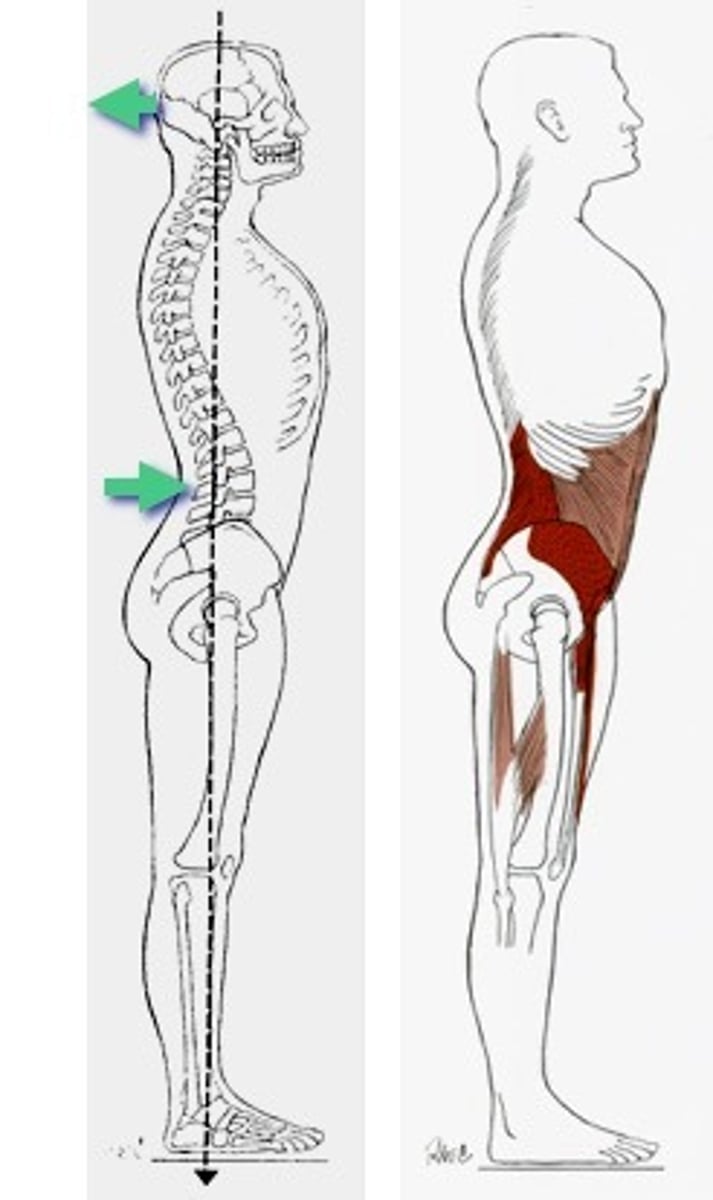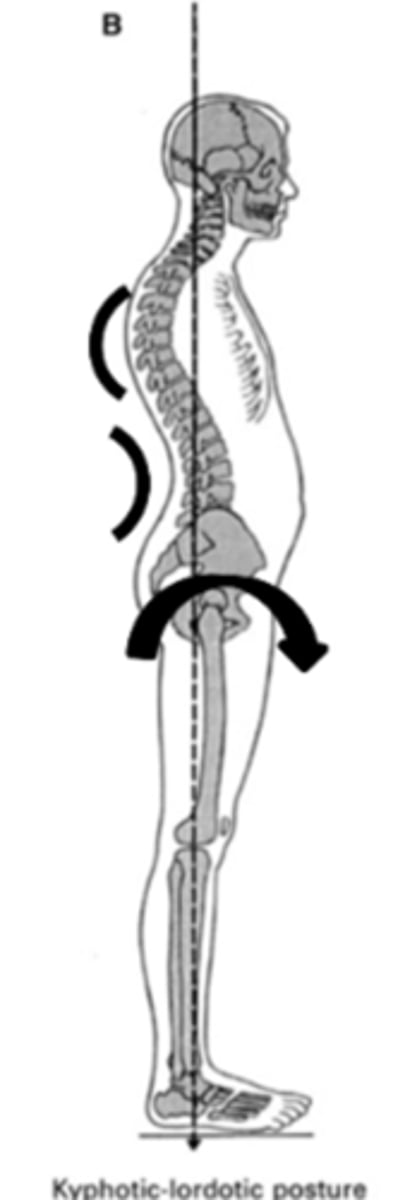Muscle Length Testing Exam Review
1/53
There's no tags or description
Looks like no tags are added yet.
Name | Mastery | Learn | Test | Matching | Spaced |
|---|
No study sessions yet.
54 Terms
What is muscle length testing?
-procedure that involves PASSIVELY stretching a muscle in the opposite direction of its action
-Stabilization occurs proximally
-Watch for any compensations
Passive Insufficiency
A two-joint muscle is lengthened to its fullest extent at both joint thus preventing the full range of motion of each joint it crosses.
Active Insufficiency
A two-joint muscle is maximally shortened across both joints simultaneously limiting the ability to produce force
Flexibility
the ability of muscles, joints and tissues to move through an unrestricted, pain free range of motion
Compensation for gastroc/soleus testing
inversion/eversion
Compensations for straight leg raise testing
-Posterior Pelvic Tilt
-Knee Flexion
-Elevation of the non-test limb off the table
Compensations for pec major testing
-Low back extension (APT)
-Trunk Rotation
Compensations for obers/modified obers
-Trunk/pelvic rotation
-Anterior or lateral pelvic tilt
-Hip flexion or internal rotation
Stabilization for Ober's/Modified Ober's
-pt is lying on flexed non-test limb to STABILIZE body
-anterior/upward pressure to pelvis to prevent pelvic tilt or rotation
Compenastion for the lats
-Anterior Pelvic Tilt
-Thoracic/lumbar extension
Does APT increase or decrease the apparent hamstring length?
Decrease
Does PPT increase or decrease the apparent hamstring length?
Increase
Straight Leg Raise (SLR) Procedure
-Pt is in supine with both legs extended
-SPTA passively flexes the test hip with knee in full extension
Soleus Testing Procedure
-Pt is in supine
-Tested hip and knee is flexed
-SPTA will passively dorsiflex the left ankle
Pec Major General Muscle Length Testing Procedure
-Patient is supine hook lying with arms interlaced behind head
-Arms are passively dropped, elbows toward table
Pec Major Clavicular Head Muscle Length Testing Procedure
-Patient is supine hook lying, arms resting at the sides, elbows extended and palms upward
-SPTA will bring the arm into 90° of flexion with shoulder in external rotation and the elbow extended.Then, slowly abduct the arm to 90°
Pec Major Sternal Head Muscle Length Testing Procedure
-Patient is supine hook lying, arms resting at the sides, elbows extended and palms upward
-SPTA will bring the arm into 90° of flexion with shoulder in external rotation and the elbow extended. Then, slowly abduct the arm to 135°
Pec minor muscle length testing starting position/stabilization
- Pt is in supine, with arms resting on the abdomen or to the side and elbows supported with a towel roll
-Hooklying to ensure back is flat on the table
What muscle is Ely's test for?
Rectus Femoris
What muscle is Ober's Test for?
TFL
What muscle is the prone extension test for?
Iliopsoas
Which muscles can Thomas/Modified Thomas test for?
Rectus Femoris
Illiopsoas
TFL
Sartorius
What is the difference between Thomas Test and Modified Thomas Test?
Thomas Test- Both knees are brought to the chest when lying supine on the plinth
Modified Thomas Test- One knee is brought down when lying supine on the plinth
What muscle is straight leg raise test for?
Hamstring
What portion of the hamstring does straight leg raise vs. 90/90 test for?
SLR- proximal
90/90- Distal
Ober's Vs. Modified Ober's
Ober's- the test knee is bent to 90 degrees
Modified Ober's- the test knee is extended
Soleus Positive/Negative Muscle Length Test Values
Positive test- less than 20 degrees of dorsiflexion
Negative test- 20 degrees or greater (≥20) of dorsiflexion
Gastroc Positive/Negative Muscle Length Test Values
Positive Test- less than 10 degrees of dorsiflexion
Negative test- 10 degrees or greater (≥10) of dorsiflexion
What part of the hamstring is straight leg raise test for?
Proximal
What part of the hamstring does 90/90 hamstring test for?
Distal
Thomas Test/Modified Thomas Test: Positive/Negative results for Iliopsoas
Positive: thigh lifts off the table (hip flexion)
Negative: thigh stays flat on the table
Thomas Test: Positive Test for TFL
abducted hip and hip IR
Thomas Test: Positive Test for Sartorius
abducted hip and hip ER
Thomas Test: Positive/Negative Test Results for Rectus Femoris
Positive Test: less than 80 degrees of knee flexion with the thigh flat on the table (knee becomes more extended;less flexed)
Negative test: 80 degrees or greater of knee flexion with the thigh flat on the table (knee is more flexed; less extension)
Give an example of where you can infer that rectus femoris AND iliopsoas might be tight when performing the Thomas/Modified Thomas Test
- If the thigh is off the table (hip is flexed) and knee flexion is LESS than 80 degrees
How can an SPTA confirm whether rectus femoris or iliopsoas is responsible for hip flexion during the thomas test?
If you extend the knee (rectus femoris is on slack), and the thigh drops down to the plinth, rectus femoris is tight.
Which muscle is most likely tight with rounded shoulders posture?
Pec minor
To test for pec minor tightness, you are measuring the distance from the ________ to the _________
posterior acromion to the plinth
Line of Gravity Posterior to the Axis of Rotation @ Knee
-If the line of gravity falls posterior to the axis of rotation at the knee, the QUADRICEPS must activate to prevent KNEE FLEXION
Line of Gravity Anterior to the Axis of Rotation @ Knee
-If the line of gravity falls anterior to the axis of rotation at the knee, the HAMSTRINGS must activate to prevent KNEE EXTENSION
Swayback Posture
-flattened lumbar curve and trunk angled posteriorly
Military Posture
-increased lumbar lordosis (tight low back extensors and hip flexors)

Flatback Posture
-decreased lumbar curve
-increased posterior pelvic tilt & hip flexion
Validity
how ACCURATE a tool is
Reliability
how CONSISTENT a tool is
Kyphotic/Lordotic Posture
increased thoracic kyphosis, increased lumbar lordosis (tight low back extensors)

Cross-Sectional Study
data is collected from different participants at a single point in time to assess the prevalence
Longitudinal Study
Tracks the same participants over time to observe changes
Experimental Study
used to establish cause and effect
Non-Experimental Study
the researcher collects data without introducing an intervention
Actual Leg Length Vs. Apparent Leg Length
True/actual leg length: This measures the physical bone length of your legs. It tells you if your legs are genuinely different in length.
Apparent leg length: This measures how your legs look from the outside. Sometimes, one leg can appear shorter due to things like pelvic tilt, muscle imbalances, posture etc.
Procedure for Measuring True Leg Length
-Pt lies in supine
-Measure from the ASIS to the umbilicus to ensure the pelvis is aligned
-If it is not aligned, the pelvis alignment should be corrected with a bridge
-THEN, measure from ASIS to ipsilateral medial malleolus
Procedure for Apparent Leg Length
-Ensure pelvis is aligned like above
-Measure from umbilicus to ipsilateral medial malleolus
How does a bridge work to bring the pelvis to neutral?
Activates the abdominals and hip extensors which work in a muscle synergy